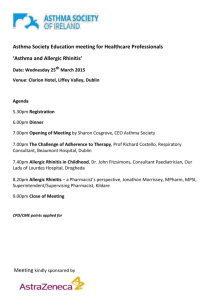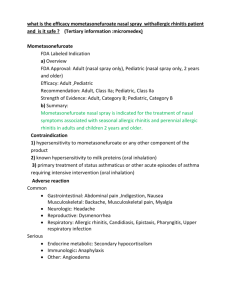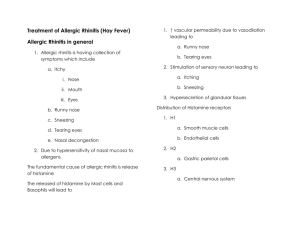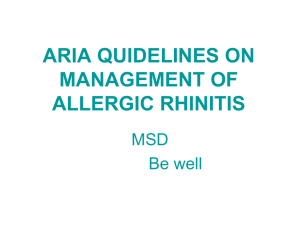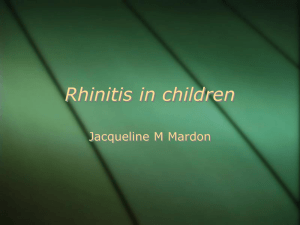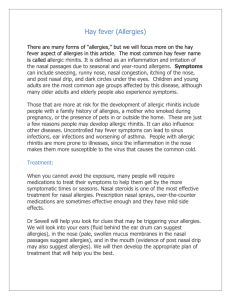The correlation between nasal staphylococcus aureus and
advertisement
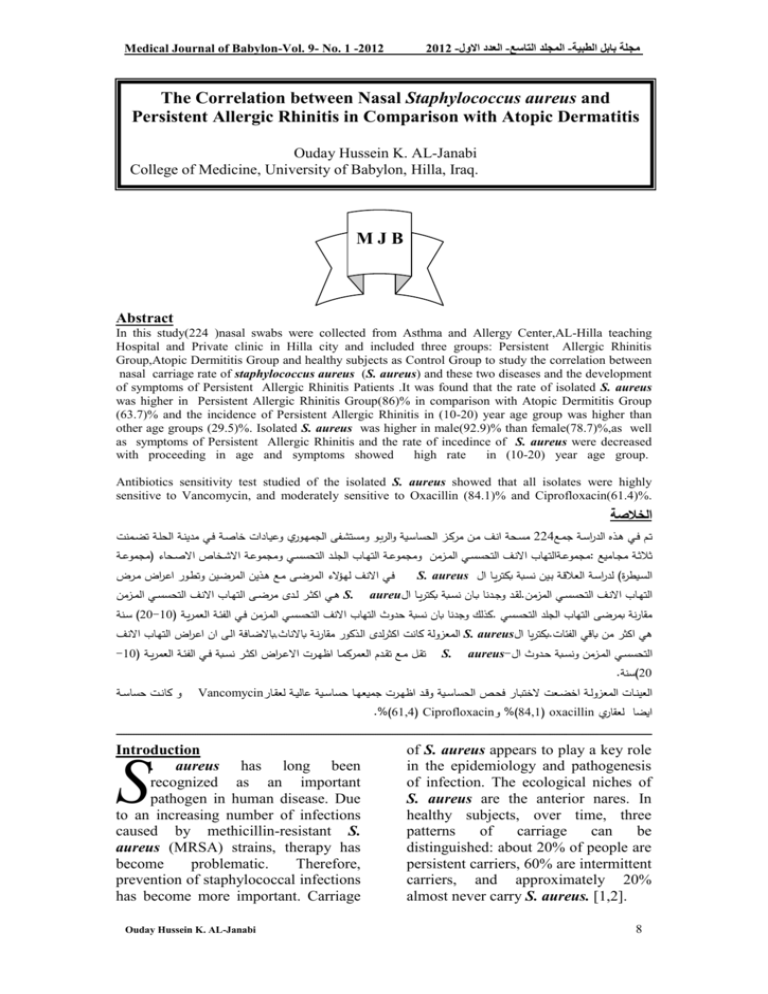
2012 - العدد االول- المجلد التاسع-مجلة بابل الطبية Medical Journal of Babylon-Vol. 9- No. 1 -2012 The Correlation between Nasal Staphylococcus aureus and Persistent Allergic Rhinitis in Comparison with Atopic Dermatitis Ouday Hussein K. AL-Janabi College of Medicine, University of Babylon, Hilla, Iraq. MJB Abstract In this study(224 )nasal swabs were collected from Asthma and Allergy Center,AL-Hilla teaching Hospital and Private clinic in Hilla city and included three groups: Persistent Allergic Rhinitis Group,Atopic Dermititis Group and healthy subjects as Control Group to study the correlation between nasal carriage rate of staphylococcus aureus (S. aureus) and these two diseases and the development of symptoms of Persistent Allergic Rhinitis Patients .It was found that the rate of isolated S. aureus was higher in Persistent Allergic Rhinitis Group(86)% in comparison with Atopic Dermititis Group (63.7)% and the incidence of Persistent Allergic Rhinitis in (10-20) year age group was higher than other age groups (29.5)%. Isolated S. aureus was higher in male(92.9)% than female(78.7)%,as well as symptoms of Persistent Allergic Rhinitis and the rate of incedince of S. aureus were decreased with proceeding in age and symptoms showed high rate in (10-20) year age group.. Antibiotics sensitivity test studied of the isolated S. aureus showed that all isolates were highly sensitive to Vancomycin, and moderately sensitive to Oxacillin (84.1)% and Ciprofloxacin(61.4)%. ي مم فممه ة نم اس م ت م ن وا م ممح اس م ممل واس ممو و متشم ا اس رممو ي والم ةا وام اتشممي ص اتمم و ة م م م وترمو اام ا است ممممه اس ممح م اتنم اس ممة است ممممه و ما م همل م اس مما استر م سرم تو اس اتنم استرم -10ارث م نمممت فممه اس ا م اسق م ة اتا م ا م اظرم مم224 م اتنم وام استر تم فممه همملد اسة امم است ممممه اس ممح م و م ل و فمه اتنم S. aureus اسمملر ) سة امم اسقال م م م نممت ت ت م ال aureuسقممة و ممةن تم م نمممت ت ت م ال.است ممممه اس ح م اتن ق نم ت تن ثات ت م ف اسما ام اام ا انم وا م استرم هممه ارث م سممةS. ممن20-10است مممه اس مح م فمه اس ام اسق م ة ممم الخالصة ةوث استر لسك و ةن ت م نمت. اس ة است ممه ارث سة اسمل و ن تقممم م تقممة اسق اس قحوسS. aureusال S. ثالثم اتن م ا استر ق ن ت ت ت. م ت ه اس ا aureus-ممةوث ال استرم هه ارث است ممممه اس ممح م ونمممت . من20 م مم و نم Vancomycin م مممل ا سل م سقق م لقر م ف ممص اس م مممل و ممة اظر م تيتت م اس قحوس م اي ممق .% 61,4 ةCiprofloxacin و% 84,1 ةoxacillin سقق ي اسق ن م ال مممممممممممممممممممممممممممممممممممممممممممممممممممممممممممممممممممممممممممممممممممممممممممممممممممممممممممممممممممممممممممممممممممممممممممممممممممممممممممممممممممممممممممممممممممممممممممممممممممممممممممممممممممممممممممممممممممممممممممممممممممممممممممممممممممممممممممممممممممممممممممممممممم Introduction . aureus has long been recognized as an important pathogen in human disease. Due to an increasing number of infections caused by methicillin-resistant S. aureus (MRSA) strains, therapy has become problematic. Therefore, prevention of staphylococcal infections has become more important. Carriage S Ouday Hussein K. AL-Janabi of S. aureus appears to play a key role in the epidemiology and pathogenesis of infection. The ecological niches of S. aureus are the anterior nares. In healthy subjects, over time, three patterns of carriage can be distinguished: about 20% of people are persistent carriers, 60% are intermittent carriers, and approximately 20% almost never carry S. aureus. [1,2]. 8 Medical Journal of Babylon-Vol. 9- No. 1 -2012 Rhinitis is a global problem and is define as the presence of at least one of the following: congestion, rhinorrhea, sneezing, nasal itching, and nasal obstruction. The two major classifications are allergic and nonallergic rhinitis. Allergic rhinitis occurs when an allergen is the trigger for the nasal symptoms. Nonallergic rhinitis is when obstruction and rhinorrhea occurs in relation to nonallergic, noninfectious triggers such as change in the weather, exposure to caustic odors or cigarette smoke, barometric pressure differences, etc [3]. In Western countries between 10– 25% of people annually are affected by allergic rhinitis [4]. Allergic rhinitis may also be classified as Mild-Intermittent, Moderate-Severe intermittent, MildPersistent, and Moderate-Severe Persistent. Intermittent is when the symptoms occur <4 days per week or <4 consecutive weeks. Persistent is when symptoms occur >4 days/week and >4 consecutive weeks [5]. In such individuals, the allergen triggers the production of the antibody immunoglobulin E (IgE) causing the release of inflammatory mediators such as histamine (and other chemicals)[6]. Atopic dermatitis (AD) is a chronic inflammatory skin disease associated with cutaneous hyperreactivity to environmental triggers that are innocuous to normal nonatopic individuals [7]. AD usually presents during early infancy and childhood, but it can persist into or start in adulthood [8]. In addition to increased colonization, 50–60% of the Staphylococcus aureus found in AD patients are toxin producing [9] Furthermore, AD patients can rapidly advance to superinfection with 107 organisms per cm2 in acute lesions, as opposed to nonatopic subject who maintain a low bacterial burden [10]. Ouday Hussein K. AL-Janabi 2012 - العدد االول- المجلد التاسع-مجلة بابل الطبية About 30% of patients with AD report bacterial infections [11]. Patients and Methods (224) nasal swabs were collected from patients attending Asthma and Allergy Center, Hilla Teaching Hospital and Private clinic in Hilla city. They were divided into three groups (78) Persistent Allergic Rhinitis Group, (66) Atopic Dermatitis Group and (80) healthy subjects as Control Group. The nasal swabs were inoculated on culture media (Trypticase soy agar (TSA) with 5% sheep blood agar, Mannitol salt agar) and incubated at 37°C for 24hr.Traditional biochemical tests were used for final identification of bacterial isolates. The traditional method for differentiating S. aureus (coagulase positive) from coagulasenegative staphylococci in the laboratory has been the tube coagulase test (TCT). This test has been modified for direct detection of the organism from blood cultures in 2 h by using the blood culture broth [12, 13]. Some antibiotic disks were used to show the effect of them on isolated bacteria using disk diffusion method. Suspension with bacteria was swabbed over a Mueller-Hinton agar. Discs impregnated with various antibiotics are placed onto agar and incubated for 24 hours at 37 °C. Zones of inhibition of bacterial growth, measured around discs, were compared with those in the National Committee for Clinical Laboratory Standards (NCCLS) [14]. Statistical analysis All data analyzed by using Chisquare and Student s unpaired t -test. A P- value <0.05 was considered statistically significant [15]. Results and Discussion Nasal carriage of S. aureus exerts immunomodulatory effect in patients with Atopic Dermatitis and it 9 Medical Journal of Babylon-Vol. 9- No. 1 -2012 may contribute to airway inflammation and allergic response in patients with allergic rhinitis [16]. So this study was designed to investigate the frequency of nasal S.aureus carriage in Persistent Allergic Rhinitis patients and its possible influence on their symptoms in comparison with the frequency of nasal S.aureus carriage in patients with Atopic Dermatitis .It was chosed (78) non smoker patients with Persistence Allergic Rhinitis (matched for age , sex and symptoms), (66) non smoker Patients with Atopic Dermatitis and (80) non smoker healthy subjects, For all subjects rhinoscopy was done, the Persistent Allergic Rhinitis group showed high nasal carriage rate of S. aureus (86)% in comparison with Atopic Dermatitis group (63.7)% and control group (28.8)% (P<0.05 significant difference) as illustrated in Table (1). Nasal S.aureus actively modulated the immune reaction in persistent allergic rhinitis patients by promoting local IgE production as well as patients with allergic rhinitis suffering from ulceration of nasal mucosa ,this may lead to increase colonization of staph aureus in nose [16]. The anterior nares have been shown to be the main reservoir of S. aureus in both adults and children. The S. aureus is transmitted to nares by contaminated hands and from surfaces where it can survive for months [17] ,this may be another factor for increasing of nasal S. aureus in Atopic Dermatitis patients by contaminated hand especially after itching of the skin. Chronic skin colonization with S. aureus is a characteristic feature of Atopic Dermatitis (AD) [18].About 6090% of S. aureus strains isolated from the skin AD patients (19).Bacterial counts on unaffected skin are lower than on affected a topic skin [ 20]. Ouday Hussein K. AL-Janabi 2012 - العدد االول- المجلد التاسع-مجلة بابل الطبية Table (2) shows the rate of nasal S. aureus which was higher in (10-20) year age group(31.3%) in comparison with other age groups. Persistent carriage of S. aureus is more common in children than in adults [21]. The symptoms also were higher in (10-20) year age group (29.5) % in comparison with other age groups. Total immunoglobulin E levels increased with age until (14-15) years, and declined thereafter [22]. Allergic rhinitis (AR) is characterized by one or more symptoms including sneezing, itching, nasal congestion, and rhinorrhea [23],so the symptoms in table (2) represent one or more of sneezing, itching, nasal congestion, and rhinorrhea. Allergic diseases of the airways, including asthma and allergic rhinitis, remain highly prevalent with associated symptoms placing considerable restrictions on the physical, emotional, and social functioning of the affected individual. It is now recognized that immunoglobulin E (IgE) plays a central role in mediating the allergic response that follows exposure to allergens after an initial process of sensitization [24]. Both of nasal S. aureus carriage rate and symptoms in Persistent Allergic Rhinitis patients showed high prevalence in (10-20) year age group and decrease as the age proceed. Table (3) shows the nasal carriage rate of S. aureus in male (92.9)% which was higher than female (77.8)%(P<0.05 significant difference). So we recommend that S. aureus carriage must be screened on regular intervals in Persistent Allergic Rhinitis and Atopic Dermatitis patients. Nasal S. aureus carriage follow-up and treatment is a process that will protect patients from more severe clinical pictures. Antibiotics sensitivity tests showed high sensitivity (100%) of S. 10 Medical Journal of Babylon-Vol. 9- No. 1 -2012 aureus to Vancomycin and in lesser degree of other antibiotics as showed in Table (4). References 1-Kluytmans J.,van Belkum A., and Verbrugh H.(1997). Nasal carriage of Staphylococcus aureus: epidemiology, underlying mechanisms, and associated risks. Clin Microbiol Rev. July; 10(3): 505–520. 2-Von Eiff C, Becker K, Machka K, Stammer H. and Peters G.(2001). Nasal carriage as a source of Staphylococcus aureus bacteremia. Study Group. N Engl J Med. Jan 4;344(1):11-6. 3-Tran N., Vickery J.and Blaiss M.(2011). Management of rhinitis: allergic and non-allergic. Jul;3(3):14856. 4-Bousquet J, Reid J and Van Weel C.(2008). Allergic rhinitis management pocket reference . Allergy Aug; 63 (8):990-996. 5-Dykewicz M. and Hamilos D.(2010). "Rhinitis and sinusitis". J. Allergy Clin. Immunol, 125 (2 Suppl 2): S103– 15. 6-May J. and Smith P.(2008), Allergic Rhinitis. In: Dipiro JT, Talbert RL, Yee GC, et al eds.Pharmacotherapy: A Pathophysiologic Approach. 7th ed. New York, NY: The McGraw-Hill Companies, Inc; :1565-1575). 7-Leung D. and Bieber T.(2003). Atopic dermatitis. Lancet. 361:151160. 8-Spergel, J.and Paller A. (2003) .Atopic dermatitis and the atopic march. J. Allergy Clin. Immunol. 2003. 112:S128-S139. 9-Akiyama H., Toi Y., Kanzaki H., Tada J.and Arata J .(1996). Prevalence of producers of enterotoxins and toxic shock syndrome toxin-1 among Staphylococcus aureus strains isolated from atopic dermatitis lesions. Arch Dermatol Res 288:418–420. Ouday Hussein K. AL-Janabi 2012 - العدد االول- المجلد التاسع-مجلة بابل الطبية 10-Leung D.and Bieber T. (2003).Atopic dermatitis.Lancet 361: 151–160. 11-Christophers E.and Henseler T. (1987), Contrasting disease patterns in psoriasis and atopic dermatitis. Arch Dermatol Res 279(Suppl):S48–S51. 12-Garrity G.(2001). Bergy's Manual of systematic Bacteriology. 2nd ed. Springer-Verlage , N.Y. vol.3., Group17. 13- Forbes B., Sahm D. and Weiss feld, A.(1998). Baily & Scotts. Diagnostic Microbiology . 10th ed. Vol.1 , Mosby co. St Louis., pp:68280. 14-Bauer R.,Kirby M.,Sherris J. and Turck M.(1966).Antibiotics by standardized single disk method. Amercan Journal of Clinical Pathology.45:493-496. 15-Daniel W. and Mugge. (1995).Transesophageal echocardiography. N Engl J Med. 332:12681279. 16- Maged M., Tarek M., Zeinab A., Mohamed Y.(2008). Immunological role of nasal staphylococcus aureus carriage in patients with persistent allergic rhinitis.The Pan African Medical Journal;1:3. 17-Van Belkum A., Verkaik N., Vogel C., Boelens H., Verveer J.and Nouwen J.(2009). Reclassification of Staphylococcus aureus Nasal Carriage Types. J Infect Dis. Jun 15 ;199(12):1820-6. 18-Breuer K., HAussler S., Kapp A. and Werfel T. (2002). Staphylococcus aureus: colonizing features and influence of an antibacterial treatment in adults with atopic dermatitis. Br J Dermatol 147:55–61. 19-Guzik T., Bzowska M., Kasprowicz A., Czerniawska-Mysik G., Wojcik K. and Szmyd D. (2005). Persistent skin colonization with Staphylococcus aureus in atopic dermatitis: relationship to clinical and 11 2012 - العدد االول- المجلد التاسع-مجلة بابل الطبية Medical Journal of Babylon-Vol. 9- No. 1 -2012 immunological parameters. Clin Exp Allergy 35:448–455. 20-Leung D., Nicklas R., Li J., Bernstein I., Blessing-Moore J.,and Boguniewicz M. (2004). Disease management of atopic dermatitis: an updated practice parameter. Joint task force on practice parameters. Ann Allergy Asthma Immunol 93:S1–S21. 21-Kluytmans J, Van Belkum A and Verbrugh H.(1997). Nasal carriage of Staphylococcus aureus: epidemiology, underlying mechanisms, and associated risks. Clin Microbiol Rev , 10(3):505520. 22-Bousquet J, Reid J.and Van Weel C.(2008). Allergic rhinitis management pocket reference . Allergy Aug; 63 (8):990-996. 23-Skoner D.(2001). Allergic rhinitis: definition, epidemiology, pathophysiology, detection, and diagnosis. J Allergy Clin Immunol Jul;108(1 Suppl):S2-8 24-Berger W.(2006).Treatment of allergic rhinitis and other immunoglobulin E-mediated diseases with anti-immunoglobulin E antibody. 27(2):29-32. Table 1 Distribution of Nasal S.aureus incidence in patients groups and Control Group. Atopic Persistence Control Total Dermatitis Allergic Group Rhinitis S. aureus No. % No. % No. % No. % + 42 63.7 67 86 23 28.8 132 58.9 _ 24 36.3 11 14 57 71.2 92 41.1 Total No. 66 100 78 100 80 100 224 100 P<0.05 Table 2 shows the distribution of Nasal S.aureus incidence in Persistence Allergic Rhinitis according to age and symptoms. Age(year) Persistent Allergic Rhinitis 10-20 21-30 31-40 41-50 51-60 No No No No % No. % No. % + s.aureus isolates 21 31.3 17 25.3 15 22.4 9 13.5 5 7.5 67 100 symptoms 23 29.5 24.3 16 20.5 12 15.4 8 10.3 78 100 19 % % % Total P<0.05 Ouday Hussein K. AL-Janabi 12 2012 - العدد االول- المجلد التاسع-مجلة بابل الطبية Medical Journal of Babylon-Vol. 9- No. 1 -2012 Table 3 Distribution of Nasal S.aureus in Persistent Allergic Rhinitis according to sex. Sex Male Study group Persistent Allergic Rhinitis Female Total No.+ No % 42 92.9 39 Total Total No.+ % No 36 28 77.8 Total No Total No+ 78 67 P<0.05 Table 4 Susceptibility of isolated S. aureus to different antibiotics. Result Sensitive Resistance Antibiotics No. % No. % Total No. % Vancomycin 132 100 0 0 132 100 Oxacillin 111 84.1 21 15.9 132 100 Ciprofloxacin 81 61.4 51 132 100 Ouday Hussein K. AL-Janabi 38.6 13
